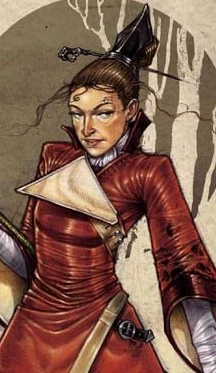| Peer | |
|---|---|
 Europe, the duchess-in-waiting of Naimes. | |
| Alternate names | Lords and Nobles |
| Type | Nobility Ruling class |
| Notable examples | Europe Madigan Narsesës Syntychë |
| Appearances | Series |
A peer is the member of the nobility, which is at the top of the social pyramid in most countries of the Harthe Alle and especially in the Haacobin Empire. Being a peer conveys tremendous advantage in terms of wealth and status. Certain ranks and positions, such as being the regent of a city-state, a minister in the Imperial Parliament, or an an Imperial magistrate, are typically held by peers. They also have the ancient right of quo gratia, which allows them to circumvent certain laws or the due process for personal gain, although this persists more in the Soutlands. The successor to a title in the case of females is referred to as their future title with the phrase "-in-waiting" added, but was not specified for males.
The following peers are ranked in order from highest to lowest in the Haacobin Empire.
Emperor and Empress[]
An emperor or empress is the supreme ruler of an empire. The current emperor of the Haacobin Empire is Scepticus XLV Haacobin Menangës. Other empires include the Gott Empire, Heilgoland, Nenin, and the Turkmantine Empire, whose emperor is known as the Püshtän. It is not mentioned if any of these empires may also be ruled by an empress.
King and Queen[]
A king or queen is the supreme ruler of a kingdom. In the Haacobin Empire the titles of king and queen are prohibited to prevent the regents of the city-states from seeing themselves on par with the emperor or empress. The sole exception to this rule is the Gightland Queen, the ruler of Catalain. The records of this ancient right are kept secret and it has been respected by all Haacobin monarchs. The Pilts have been allowed to retain a king who lacks real power and is a figurehead.
While monster-lords typically use the title of duke or duchess, an example of one who also uses a monarchical title is the Spider Queen.
Prince and Princess[]
A prince and princess may be either a member of a monarch's family or the ruler of a principality. They are rare in the Haacobin Empire but are more common elsewhere and among the Antique Sanguines. Burgundy was ruled by princes who founded Brandenbrass until the title was demoted to archduke. Princess Awahb is the ruler of the Principalitine. Europe mentioned that "some besotted Occidental princeling from Sippon" had gifted her with a set of bom e'do which she used to furnish the solar of Cloche Arde and her factotum's room.[1] Cinnamon is referred to several times as a bogle-prince or bogle-princeling, reflecting the his position as a nuglung being subordinate to that of his monster-lord, the Duke of Sparrows.

Archduke Narsesës of Brandenbrass
Archduke/Grand Duke and Archduchess/Grand Duchess[]
Archduke or Grand Duke and Archduchess or Grand Duchess is the highest class of duke or duchess. Brandenbrass is an archduchy currently ruled by Narsesës.
Duke and Duchess[]
A duke or duchess is the more common ruler of a city-state or duchy. Hergoatenbosch[2] and Naimes are duchies. Interestingly, either title is also used by the monster-lords. Europe is a Duchess-in-waiting.
Marche and Marchess[]
The role of a marche or marchess may vary, but so far they have not been shown to be rulers of city-states. Madigan and Syntychë are marchesses. The rank's position between duke and count reflects that of the real world position of a marquess or marquis and marchioness or marquise.
Earl/Count and Countess[]

The Eighth Earl of the Baton Imperial of Fayelillian.
The territory ruled by an earl or count or countess is a countenancy. Philemon Plume is the count in absentia of Windspect Folia. The Lamplighter-Marshal in command of the lamplighters on the Conduit Vermis is the unnamed Eighth Earl of the Baton Imperial of Fayelillian.
Baron and Baroness[]
A baron or baroness would control a barony. A notable baron is Idias Finance, the Chief Emissary of Naimes' diplomatic mission to Brandenbrass.
Viscount/Reive and Viscountess/Revine[]
A viscount or reive or viscountess or revine is the second-lowest ranked peer. In the case of Brandenbrass, it appears that reive and revine are more common in the rural areas or parishes. The archduke mentioned the Reive of Lo during his meeting with Europe[3] and two sets of reives and revines were introduced to her during the gala at the Patredike.[4]
Viscount and viscountess exist in the real world. Reive is actually an archaic spelling of "reave", an old term for pillage or plunder. Revine does not have a real world equivalent. Reeve or its equivalent vogt might be a more plausable alternative, although neither of these positions were of the nobility.
Baronet and Baronetess[]
Baronet or baronetess is the lowest ranked peer.
Bloodlines[]
Among peers certain bloodlines are considered superior:
- Antique Sanguines: Ancient families who can trace their heritage and rank to before the beginnings of the empire.
- Corvinius Arbour family: A prominent family from Boschenberg which has ties to Brandenbrass' Saakrahennemus family. Gosling Corvinius Arbour is a member of this family but was rejected by his parents.
- Didodumese: The most superior bloodline, comprising those who claim descent from the empress Dido. The current Haacobin Dynasty notably is not among of these.
- Saakrahennemus family: A prominent family from Brandenbrass with ties to the Corvinius Arbours of Boschenberg. Rookwood Saakrahenemus Fyfe is a member of the family on his mother's side.